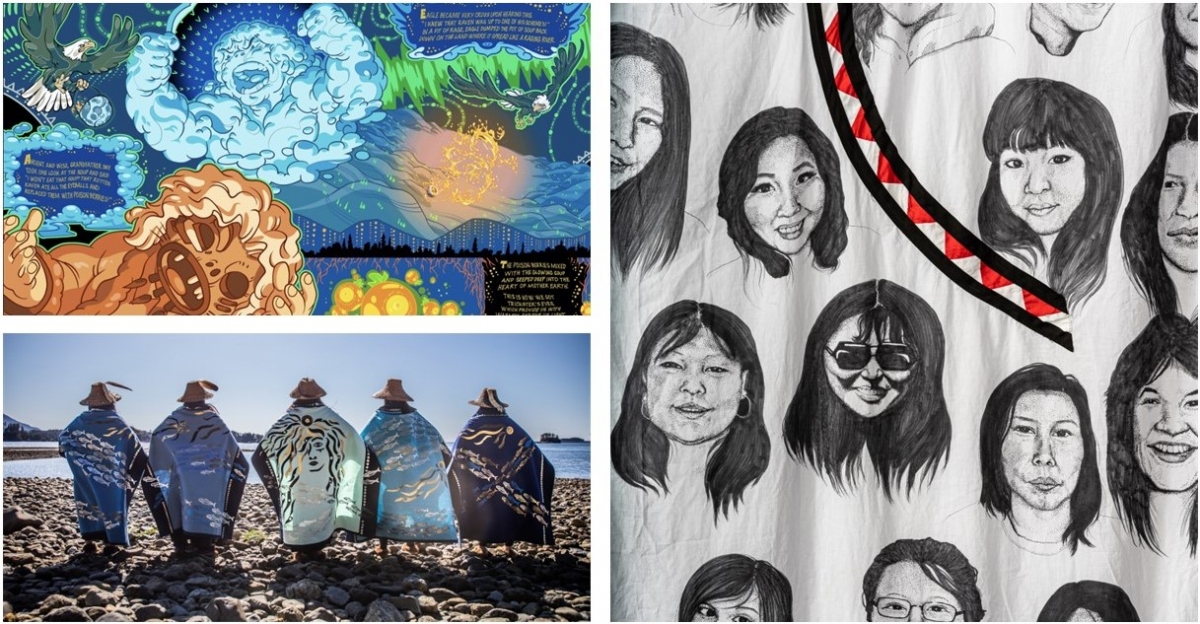Protection: Adaptation and Resistance

Protection: Adaptation and Resistance
December 3, 2023 - April 7, 2024
The traveling exhibition Protection: Adaptation and Resistance presents the work of more than 45 Alaska Native artists who explore the themes of climate crisis, struggles for social justice, strengthening communities through ancestral knowledge, and imagining a thriving future.
The diverse works in the exhibition range from regalia to images of traditional tattooing, graphic design, and posters for public health and well-being. Iñupiaq artist Amber Webb’s 12-foot-high qaspeq (a cloth hooded overshirt) features the drawn portraits of more than 200 Indigenous women who have been missing or murdered in Alaska since 1950. This Memorial Qaspeq makes visible the scale of loss and grief the tragedy of Missing and Murdered Indigenous Women and Girls (MMIWG) has in Indigenous communities, and with this installation, Webb calls for a solution to violence against women and healing for Native communities.
Protection: Adaptation and Resistance is a project of the Bunnell Street Art Center in Homer, Alaska. It is made possible, in part, with support from the National Endowment for the Arts, The CIRI Foundation, the Alaska Community Foundation, Rasmuson Foundation, and the Alaska Humanities Forum.
Protection complements the MOIFA exhibition Ghhúunayúkata/To Keep Them Warm: The Alaska Native Parka, which opened at the museum in May 2023. The idea of protection is also inherent in Ghhúunayúkata/To Keep Them Warm, which examines the Alaska Native parka, a garment made for survival in the harsh environments where Alaska Native peoples live and thrive. Both exhibitions will be on display through April 7, 2024.
“Protection: Adaptation and Resistance centers Indigenous ways of knowing. Working within intergenerational learning groups and as collaborators in vibrant community networks, Alaska’s Indigenous artists invigorate traditional stories and propose resilient new futures through design, tattoo, regalia, and graphic arts,” said exhibition curator and Bunnell Street Art Center director, Asia Freeman. “The projects featured in this exhibition elevate collaboration, allyship, and community as tools of resistance, adaptation, and cultural affirmation.”The diverse works in the exhibition range from regalia to images of traditional tattooing, graphic design, and posters for public health and well-being. Iñupiaq artist Amber Webb’s 12-foot-high qaspeq (a cloth hooded overshirt) features the drawn portraits of more than 200 Indigenous women who have been missing or murdered in Alaska since 1950. This Memorial Qaspeq makes visible the scale of loss and grief the tragedy of Missing and Murdered Indigenous Women and Girls (MMIWG) has in Indigenous communities, and with this installation, Webb calls for a solution to violence against women and healing for Native communities.Some of the artists included in Protection include: Bobby Brower, Lily Hope, Melissa Ingersoll, Joel Isaak, Cassandra Johnson, Tommy Joseph, Dimi Macheras, Helen McLean, Holly Nordlum, Jackie Qataliña Schaeffer, Melissa Shaginoff, Hanna Sholl, Marjorie Tahbone, Beverly Tuck, Sarah Ayaqi Whalen-Lunn, Crystal Worl, Rico Worl, and Jennifer Younger, Louise Brady and Carol Hughey.
Kaxhatjaa X’óow/Herring Protectors, 2021
Created by K’asheechtlaa (Louise Brady), Káakaxaawulga (Jennifer Younger), and Carol Hughey with various volunteers. Herring design by Kitkun (Charlie Skultka Jr.)
Wool felt, silk WWII Japanese parachute cloth, metallic fabrics, ribbon, mother-of-pearl, akoya shell, abalone, dimes
Photo credit: Caitlin Blaisdell
Courtesy of Bunnell Street Arts Center